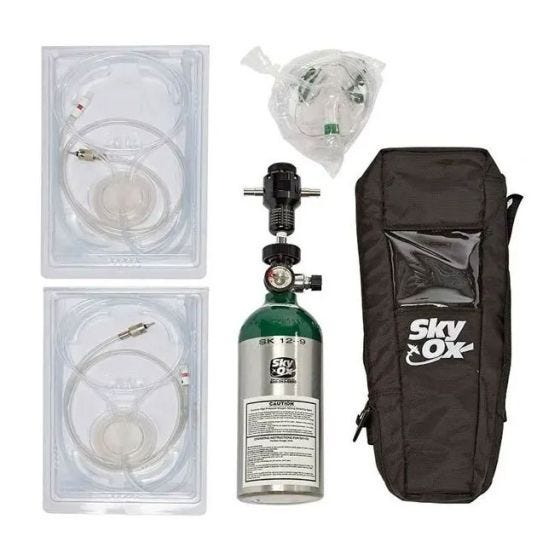2-Place Cannula Oxygen System (2 Nasal Cannulas - 1 Mask)

In stock
Backordered
Notes
A portable oxygen system can significantly increase safety, passenger comfort and your airplane’s utility. SkyOx systems are feature rich, easy-to-use, and offer the highest quality. Don’t fall victim to Hypoxia. Arrive at your destination in comfort by using these systems.
Features:
- Click-a-breath regulator is really easy to use
- No confusing electronic controls
- Oximizer cannula nearly triples the duration of each bottle
- Each system includes 2 cannulas and one mask
- Aluminum tanks provide great capacity at minimum weight
- Made in the USA for over 40 years
- All systems include a free padded carrying case
| Capacity | Dimensions | Weight | Cannula | Mask |
| 6 cu. ft. cylinder | 16 3/8"l x 3 1/4 dia. | 6 lbs. | 5:28 hrs. | 1:49 hrs. |
| 9 cu. ft. cylinder | 15 1/2"l x 4 3/8 dia. | 7 lbs. | 8:07 hrs. | 2:45 hrs. |
| 15 cu. ft. cylinder | 21 1/4"l x 4 3/8 dia. | 11 lbs. | 13:48 hrs. | 4:36 hrs. |
| 22 cu. ft. cylinder | 24"l x 5 1/4" dia. | 12 lbs. | 20:73 hrs. | 6:45 hrs. |
| 24 cu. ft. cylinder | 30 1/4"l x 5 1/4 dia. | 14 lbs. | 22:42 hrs. | 7:34 hrs. |
*Duration times for Cannula & Mask are man hrs. @ 15,000 ft.
Filled systems are available for an additional $80. (48 contiguous states only).
Why buy a portable oxygen system?
Increase pilot safety
Hypoxia is a far more common problem than most pilots admit, and is not limited to pilots of turbocharged or high performance aircraft. Many pilots need oxygen below the 12,500 feet specified in the FARs. Carrying a portable oxygen system is the only way to protect against the serious and difficult to detect symptoms of hypoxia.
Increase passenger comfort
Do you or your passengers always arrive tired or with a headache? It’s probably because of mild hypoxia. Spending three hours at 10,000 feet is often enough to cause discomfort. And on average, women need oxygen 2,000 feet lower than men. An oxygen system can help you and your passengers arrive comfortably.
Increase your airplane’s utility
When 12,500 is no longer a barrier, you can truly make the most of your high performance airplane. You’ll be able to out-climb turbulence or weather, make use of favorable tailwinds, and even enjoy the lighter traffic between 10,000 and 20,000 feet.
Take it with you to refill
Refilling Oxygen at the airport FBO can be a costly affair. Taking your bottle off airport to fill at a medical supply store or some other filling station can result in significant savings.
Why choose SkyOx Portable Oxygen Systems?
Value
SkyOx offers complete, advanced systems, with all the features you need for safe, comfortable high altitude flight. And best of all, these systems are available from Sporty’s at excellent prices.
Oxymizer® cannula, with low profile pendant
The breakthrough Oxymizer conserving cannula is the comfortable and efficient way to use oxygen up to 18,000 feet. It nearly triples the duration from each bottle, storing oxygen in the pendant reservoir, so you only get oxygen when you need it. This is not the “mustache type” cannula found on other systems. Eating, drinking and talking with passengers is easy.
Easy to Use
While SkyOx systems feature advanced features and quality construction, there are no confusing electronic controls, no batteries to replace, and no multi-port valves. Just plug in, set your altitude and sit back.
Large variety of sizes and construction
No matter what your needs are for an oxygen system (be it backup or everyday use), we have a size and configuration to match, in aluminum cylinders.
Made in the USA for over 30 years
All SkyOx oxygen systems are proudly made in the USA, guaranteeing exceptional quality and lasting value.
Padded Carrying Bag included free!
Each SkyOx system includes a custom carrying bag. A $50 value—free!
Each system includes an aluminum oxygen cylinder, regulator (two-place), two cannulas and one mask, flow indicators, hoses (10 feet long), fittings and padded carrying case with viewing window to monitor gauges with case closed.
The masks provide continuous-flow oxygen without special flow dividers at altitudes up to 30,000 ft. The cannulas are similar to the masks but use Oxymizer® nasal cannulas to provide more than triple the duration from the same size bottle. Cannulas may only be used at altitudes up to 18,000 ft.
Tired on hoses drapped over your ears? Upgrade from a cannula to an Aerox Boomula.





